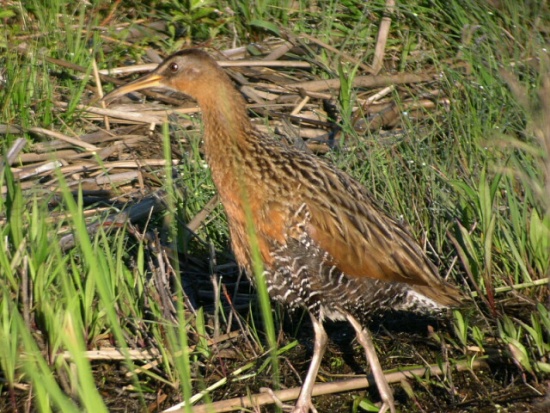Ovenbird43 (talk | contribs) (→Diet) |
Ovenbird43 (talk | contribs) m (→Habitat) |
||
| Line 23: | Line 23: | ||
Eastern [[United States]], eastern [[Mexico]], and [[Cuba]] | Eastern [[United States]], eastern [[Mexico]], and [[Cuba]] | ||
==Habitat== | ==Habitat== | ||
| − | Freshwater marshes and marsh-shrub swamp habitats. | + | Freshwater or brackish marshes and marsh-shrub swamp habitats. |
| + | |||
==Taxonomy== | ==Taxonomy== | ||
King Rail and [[Clapper Rail]] are closely related and are sometimes considered conspecific (belonging to the same species). Three subspecies are recognized. | King Rail and [[Clapper Rail]] are closely related and are sometimes considered conspecific (belonging to the same species). Three subspecies are recognized. | ||
Revision as of 14:29, 17 April 2008
- Rallus elegans
Identification
L. 14 in
Ws. 24 in
Adult
- White undertail coverts
- Red-brown face, neck, breast and wing coverts
- White throat
- Dark brown cap and hindneck
- Brown back feathers with tawny edges
- Whitish belly
Juvenile
- Pale buff head and neck
- Back and upperwings darker
- White belly
Similar Species
Similar to Clapper Rail
Distribution
Eastern United States, eastern Mexico, and Cuba
Habitat
Freshwater or brackish marshes and marsh-shrub swamp habitats.
Taxonomy
King Rail and Clapper Rail are closely related and are sometimes considered conspecific (belonging to the same species). Three subspecies are recognized.
Behaviour
Breeding
Male announces presence within territory by giving repeated hard "kek" calls. They make nests of grass or marsh vegetation constructed just above the water in bushes or clumps of marsh vegetation. May place nest anywhere from dry ground to over more than 2 ft of water. Often nest in rice fields in southeastern states. Nests are usually domed with an entrance ramp. Six to 13 buff-coloured eggs are laid. Both sexes share in incubation and rearing responsibilities. Chicks are downy black with pied white-and-black bills upon hatching. The chicks are semi-precocial, being able to walk shortly after hatching but remaining dependent on the parents for food and protection for several weeks.
Diet
Mainly crayfish and crabs, but also includes other aquatic invertebrates, small fish, insects, and some plant seeds.




